
Space Dreadnought 3000
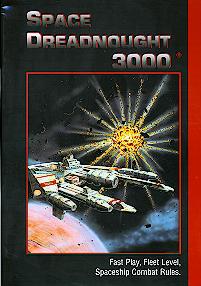
- Description
- Detailed Description
- Reviews
- Links
Back to SCIENCE FICTION SPACE COMBAT RULES
| "Enjoyment and the importance of individual expression in the use of
strategies and tactics became my prime considerations, as well as the importance
of chance and the 'what if?' factor in creating a game which is fun to play."
- Designers Notes, Space Dreadnought 3000, pg. 3 |
In the Introduction, designer Paul Kerrison details eleven design goals he had in mind for this ruleset. In summary, he desired a fast-playing system that was simple to play, functioned both on the tactical and strategic levels, and that minimized record-keeping and measurements.
Ships and Fleets
In the world of Space Dreadnought 3000, there are six space-faring civilizations fighting to win the guardianship of the vital 7th Sector:
| Earth Empire | An autocratic society formed in the aftermath of the Earth Federation's defeat by the Vargans. Humans make wide use of automation to make up for their biological deficiencies, but still use manned (as well as unmanned) fighters. |
|---|---|
| Talliscians | The respectable, sociable race that served the former Guardians as peacekeepers. Their fleets are extensive, but lack innovation. |
| Vargan Empire | Low-gravity race suffering from xenophobia and constant civil wars. Make extensive use of drones. |
| Kaylon | An ancient trading civilization, based in several other sectors of the galaxy. Uses mercenaries, but is dependent on resources outside the 7th Sector. |
| Quellaris Federation | Federation of independent planets, including major human and Vargan elements. Crews are volunteer, and ships are highly mechanised. |
| Altarans | A ruthless, aggressive race, the Altarans are rumored to be genetically-modified humans. They live to serve, are physically and mentally superior, and consider themselves expendable. |
Each civilization is associated with a line of models in the Space Dreadnought 3000 product line, although the rules state that any manufacturer's ships can be used as long as the players know what each model represents. (ID markers can be photocopied from the rulebook and placed near the models, or applied to the bases.)
All forces have the same eight ship classes (though statistics differ):
- Fighter
- Patrol Vessel
- Destroyer
- Cruiser
- Battlecruiser
- Dreadnought
- Super Dreadnought
- Baseship
Fighters function as "swarms" (players can decide whether to actually mount multiple fighters per stand, or to simply have a single fighter model represent each swarm). A Baseship, in addition to its normal combat abilities, can host up to 4 fighter swarms.
An additional ship type, common to all of the civilizations, is the Terminator. This is a merchant ship converted into a suicide ship, loaded with close-range weapons and built for making interceptions. They are rated by size (large, medium, small).
Naval bases may be used in some scenarios. These large installations begin play in a hidden location, are difficult to destroy, and may make a random number of attacks per turn.
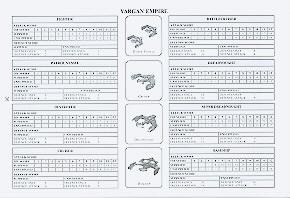
Fleet Lists provide the statistics for each civilization's ship classes, as well as their point costs, combat tables, and (in some cases) photographs. Blank record sheets are provided so that players can record their fleets.
The Tactical Game
Play takes place on a a dozen or so hexagons, arranged in any of ten recommended configurations and numbered for reference. Certain of the hexes may be designated as containing supply planets (markers provided). Fleets are organized into Task Forces, which are represented on the tabletop by markers.
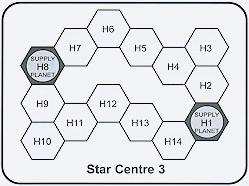
The game is played in 10 "time phases" (turns), each of which is composed of these steps:
- Write movement orders
- Reveal and execute movement
- Write combat orders
- Resolve combat
Movement orders simply consist of writing down the ID number of the hex to which the task force is to move. Task forces have unlimited movement, with one important restriction - a task force which moves through a hex containing an enemy task force which is not moving is automatically destroyed. A task force in the same hex as an enemy task force may instead choose to "pursue" the task force, in which case it will move to the same destination. (Unless the target moves through a hex containing a non-moving ally, in which case the pursuer is destroyed!)
Combat is resolved between rival task forces in the same hex. The miniatures are set up, and each ship or swarm may be given a written target (i.e., "Destroyer 2 ATTACKS Fighter Swarm 3"). Ships without written orders are assumed to be in Defensive mode.
Each ship may then make one attack, with all results considered simultaneous. A 12-sided die is rolled, and compared against the combat table for that ship to determine the strike value of the attack. If the strike value equals or exceeds the target's defensive value, the attack succeeds and the target is removed from play.
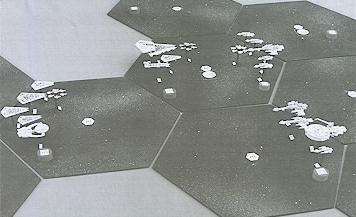
A ship's supply status has a critical effect on combat. A task force is considered "in supply" if it can trace an unobstructed path to a friendly supply planet; if not, it is "unsupplied." Ships use different combat tables depending on their supply status. A ship's defensive value depends both on its supply status, and whether it is in Defensive mode or not.
Fighters have the option of taking the role of "escort," being placed directly in front of the ship they are protecting. An escorted ship cannot be attacked in the current turn, but can still make attacks normally. Escorting fighters may not make attacks. Fighters may alternatively deploy in the battleline as starships do, or may lurk on board baseships (but if the ship is destroyed, so are all of its passengers).
| Example: At the end of movement, two rival Task Forces wind up in
the same hexagon. Combat ensues. The Talliscian task force consists of 7 units -
2 destroyers, 1 cruiser, 1 battlecruiser, 1 super-dreadnought, and 2 fighter swarms.
The Kaylon task force has only 5 units - 1 patrol vessel, 1 cruiser, 1 battlecruiser,
1 super-dreadnought, and 1 fighter swarm. The Kaylon force is supplied, while the
Talliscian force cannot trace a line of supply.
Both players deploy their ships into battlelines. The Talliscian places his fighters to escort his battlecruiser and super-dreadnought. The Kaylon likewise shields his super-dreadnought with a fighter swarm. These ships are now protected for the current combat. Combat orders are written secretly, then simultaneously revealed. The Talliscian writes:
While the Kaylon player writes:
Combat is then resolved. We'll look at one instance - the attack by the Talliscian super-dreadnought on the Kaylon battlecruiser. 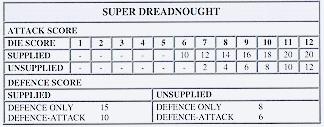 The Talliscian player rolls a d12, then consults the "unsupplied" row on the Talliscian super-dreadnought combat table. Rolling an "11," he finds that he has a strike value of 10 points. Meanwhile, the Kaylon player looks up his defensive value for his battlecruiser, under "Supplied, Defence Only" - 12. Since the defensive value beats the strike value, the battlecruiser survives this round. |
After 10 turns of play, the winner is determined by totaling the points for all surviving ships.
The Strategic Game
The rules provide two scenarios:
- Altaran v Vargan Empire - a straight-forward fight for supremacy between two equal fleets.
- Talliscian v Kaylon - a large fleet must destroy an enemy naval base protected by a smaller fleet.
Other scenarios can be devised by randomly selecting a hex configuration and picking appropriate point totals. However, players desiring more variety will probably move up to the campaign game.
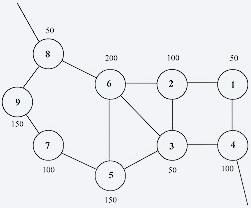
The campaign game is played on a map that consists of nodes (star centres) linked by travel lines (galactic trade routes). Each node is rated for its economic yield in points (Economic Units, or EU's).
Ships are organized into Fleets, with a limit of 1 fleet per star centre per player. Fleets can move 1 star centre per turn. If a fleet chooses not to move, it can instead collect economic points from that star centre. When the fleet reaches a naval base, it can drop off any accumulated EU's.
Naval bases can be built by spending EU's and having fleets remain in an area for a few turns. Gaining a naval base means the star centre will no longer produce EU's (they all go to maintain the base), but the naval base can be used to turn EU's (transported there by fleets) into new ships and fleets.
If, after movement, two rival fleets occupy the same star centre, then play proceeds to the tactical game. Each fleet is divided into several task forces, a hexagon configuration is randomly determined, and 10 turns of the tactical game are played out. Afterwards, a new strategic turn is played, with surviving units returning to their parent fleets.
The rulebook provides two campaign scenarios:
- Kelstron Cluster - Both the Vargan and Quellaris forces have a naval base in this cluster. The fight for supremacy begins. The Quellaris begin with more ships, but the Vargan Empire has a larger treasury.
- The Narridan Cluster - The Vargan Empire has established a naval base in a cluster bordering the Earth Empire. Three Earth fleets have been dispatched. The Earth player must decide between an early offensive, or first establishing his own naval base.
The Rest of the Rulebook
This product also includes optional rules (supply ships, command and control, etc.), optional campaign rules (including alliance rules), and rules for multi-player games (both team-play and multi-force campaigns). Extensive guidance is given for those who want to construct their own hexagon gameboards, plus tips are supplied for painting and storing starship miniatures.

For those desiring more information about the background of the game, the rulebook provides several pages detailing the civilizations, technologies, and history of their struggle. Finally, four full-color pieces of art are provided in a central section, which can be easily removed for display.